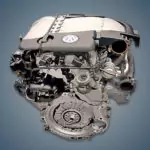The 1.5-liter Suzuki M15A gasoline engine was produced in Japan from 2000 to 2014 and installed on such popular models as Liana, Swift, Ignis and its Subaru Justy clone. A modification of this motor for the Indonesian version of the SX4 crossover is still being produced.
Engines of the M-series: M13A, M15A, M16A, M18A.
In 2000, a 1.5-liter engine was added to the M-series gasoline powertrain lineup. By design, it is very simple: here is an aluminum cylinder block with cast-iron liners and an open cooling jacket, an aluminum 16-valve cylinder head without hydraulic lifters, a timing chain drive and a dephaser on the intake. Fuel injection is only distributed.
There are two versions of the engine: a simple one with a compression ratio of 9.5 developing 100 hp and 133 Nm and an advanced one with a compression ratio of 11 and developing 111 hp and 142 Nm, it is less common. There is a modification of the unit for 109 hp for the Indonesian market, it is still being assembled.
Specifications
| Production years | 2000-2014 |
| Displacement, cc | 1490 |
| Fuel system | distributed injection |
| Power output, hp | 99 – 111 |
| Torque output, Nm | 133 – 142 |
| Cylinder block | aluminum R4 |
| Block head | aluminum 16v |
| Cylinder bore, mm | 78 |
| Piston stroke, mm | 78 |
| Compression ratio | 9.5 – 11.0 |
| Hydraulic lifters | no |
| Timing drive | chain |
| Phase regulator | at the intake |
| Turbocharging | no |
| Recommended engine oil | 5W-30, 5W-40 |
| Engine oil capacity, liter | 4.2 |
| Fuel type | petrol |
| Euro standards | EURO 3/4 |
| Fuel consumption, L/100 km (for Suzuki Ignis 2005) — city — highway — combined |
9.8 5.8 7.2 |
| Engine lifespan, km | ~350 000 |
| Weight, kg | 92 (without attachments) |
The engine was installed on:
- Suzuki Ignis 1 (FH) in 2000 – 2006; Ignis 2 (MH) in 2003 – 2008;
- Suzuki Liana 1 (ER) in 2001 – 2007;
- Suzuki SX4 1 (GY) in 2006 – 2009;
- Suzuki Swift 3 (MZ) in 2004 – 2010;
- Subaru Justy 3 (MHY) in 2003 – 2007.
Disadvantages of the Suzuki M15A engine
- The only serious problem of the motor is oil consumption at high mileage and not only stuck rings are to blame, but also the wear of seats or valve guides.
- This aluminum motor does not tolerate overheating and often breaks through the cylinder head gasket. After 200,000 km, the situation is aggravated due to subsidence of the sleeves in the aluminum block.
- Another massive problem with this unit is floating idle speeds. The reason is usually a dirty throttle or EGR valve, it also clogs quickly.
- Unreliable sensors and especially the crankshaft position sensor and the camshaft position sensor deliver a lot of trouble to owners. Ignition coils are distinguished by a modest resource, sometimes they go no more than candles.
- Also, the catalyst quickly falls apart here, oil often leaks through the pressure sensor, the supports of the power unit go a little, and the valves need to be adjusted every 30,000 km.






